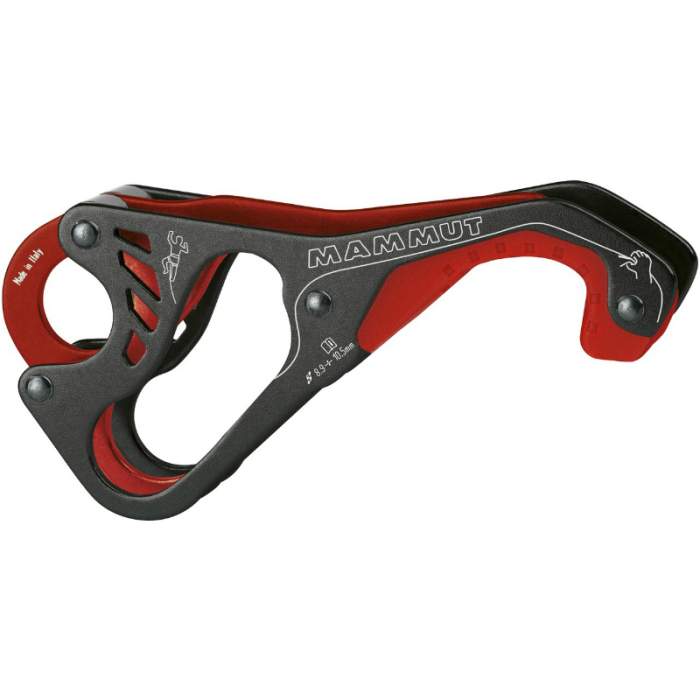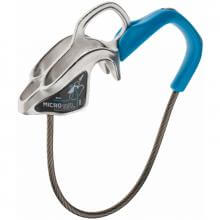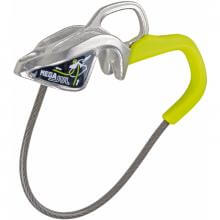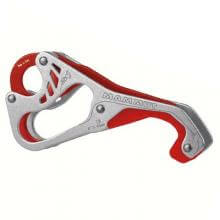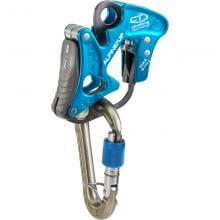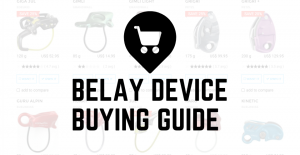Smart Alpine Large
Description
The alpine version of the award-winning Smart can also be used with half ropes as well with single ropes, making it the ideal companion for all alpine rock and ice pursuits. When it comes to belaying, the Smart Alpine offers the same excellent qualities as the Smart: dynamic braking of the climber in an accidental fall, and locks even at low levels of force exerted by the user. The Smart Alpine can also be used to independently belay one or two second climbers in an autolocking mode from the fixed point. The device is also ideal for abseiling. Black-red version for use with rope diameters of 8.7 to 10.5 mm.
Retail price
This Product is Hard to Find.
We don’t know where you can buy this item online in the US. We’ll continue to check all the major retailers and will update this page as soon as we find one.
If you know where to find this online in the US, let us know, and we’ll add the link.

Device Type  Device TypeTubeThe most commonly used belay type also called an “ATC” or “tuber.” Other than a distinction between other belay device types, “Tube” is a rarely used term, most climbers just assume you're talking about this style when they refer to your "belay device." 
Figure 8Mostly used in rescue, canyoneering, tactical, work safety, or by old school climbers and rappellers. One reason they went out of popularity with recreational climbers is because they tend to create twists in the rope. 
Brake AssistThese devices assist in stopping the rope when a climber falls or hangs on the rope. 
Often referred to as “auto-blocking” but that’s not the official terminology because no belay device should be assumed to work automatically by itself, even if it feels like it does (or does most the time). PlateWhen simplicity is a must, or you started climbing before Tubers were the norm. Bonus: They tend to be very light weight. 
DescenderFor rappelling, not for belaying a lead climber or top-roping. 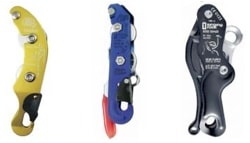 |
Brake Assist - Tube |
Weight (g)  Weight (g)In grams, the weight, as stated by the manufacturer/brand. |
135 g |
Belay Brake Assist  Belay Brake AssistThis is when the belay device significantly reduces the amount of holding power the belayer must exert to stop a fall and hold a climber. This is also called "assisted-braking" as the device must hold a significant amount of the climber’s weight; this term does not include friction-adding "teeth" found on some tube style belay devices. Confusingly referred to as “auto-blocking” or “auto-locking” these terms wrongly imply the device will always, automatically, stop a fall or hold a climber even if the belayer/rappeller is hands-free. These devices are not meant to be used without a hand on the braking side of the rope; the belayers/rapppeller brake hand should always be on the brake rope. Worth ConsideringMost of the mechanical brake assist devices only hold a single strand of rope and are not capable of double-strand rappelling (the most common method of rappel). |
Yes |
| Rope Options | 1 rope only |
Guide Mode  Guide ModeThis is when you belay directly off the anchor instead of your harness. Guide mode is helpful if you climb outdoors a lot because it reduces the holding power required from the belayer. When your partner falls or rests, the weight of the climber is held mostly by the anchor and the belay device. Tubers and PlatesWhen belaying in "guide mode," the tubers and plates turn auto-blocking. During a fall, the climbing rope pinches the slack rope, completely stopping the movement of either rope. A common guide mode setup shown below. 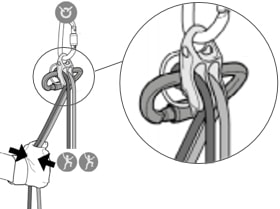
Mechanical Brake Assist DevicesThere is no difference in the functionality of the device. A brake-hand should always be on the rope to ensure the climber is caught in the case of a fall. A common guide mode setup shown below. 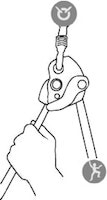
Where guide mode is used
Learn Morehttp://www.climbing.com/skill/essential-skills-auto-blocking-belay-devices/ |
Up to 2 followers |
Teeth  TeethTeeth are only seen on tube devices. They add friction that helps grip the rope for more belaying control. This is helpful for belaying heavier climbers. Teeth are becoming standard on new tube devices. 
Worth ConsideringTeeth do wear out. You can limit wear by rappelling on the side without teeth (if you don’t need the extra friction). Once they’re worn, you’ll still have a usable belay device, just less friction. |
No |
Rope Range (mm)  Rope Range (mm)The range of rope diameters, in millimeters, that the manufacturer/brand specifies can safely be used. This is the best case scenario and does not necessarily take into consideration that certified ropes have a tolerance of +/- .3 mm. Recently, manufacturers have started to add an "optimized" rope range -- this is the range that will result in the nicest handling of the belay device. | 8.9 mm - 10.5 mm |
Certification  CertificationsThe main climbing gear certifications are CE and UIAA--and normally the UIAA creates the rules that the CE body also supports. When possible, we try to list all the certifications the product carries. To sell a climbing product in Europe, the device must be CE certified. There are no official requirements to sell climbing gear in the US. The UIAA certification is a voluntary process. Learn MoreRock and Ice Certifications Guide |
|
The Smart Alpine is a heavier than an ATC or Reverso, but I really like the additional safety that the autolocking feature provides. As a belayer, you try to always be ready for the big fall and big catch, but the autoblock gives you a bit of a back up just in case you screw it up. When fatigue sets in at the end of a long alpine day, it’s good to have that extra assist from your belay device.
Mammut bills its Smart device as a tool for gym and sport climbers, and this no-frills “auto-locker,” designed to brake at even low levels of force, will work for those applications. The $50 price tag will further entice frugal climbers looking for the convenience and safety of traditional auto-lockers, which typically cost nearly $100. I used the Smart a lot last summer and quickly realized that it locks more readily than other devices, and lowering, rappelling or feeding slack can be jerky until you master the technique. After a few test runs I had it down, but the Smart was never as easy to operate as a Grigri. That said, the Smart offers advantages over other auto-lockers that extend beyond sport and gym venues. For example, the Smart weighs five ounces less than the Grigri, and I enjoyed the weight savings on multi-pitch outings where I could rig it at the anchor and more easily hold my partner if he fell. Like the Grigri, the Smart doesn’t work with double ropes. The Smart works with thin ropes—from 8.9 to 10.5 mm, though the Faders Sum also takes ropes down to 9.1 mm. In the final analysis, this single-rope device doesn’t quite deliver the smooth-as-butter action of traditional auto-lockers, but is serviceable and light, and the price is right.
For all that this belay device does, Mammut should charge twice as much. For a start, the Smart Alpine can handle double-rope rappels and auto-block mode to belay one or two seconds; it’s equally at home on single-pitch and multi-pitch routes, unlike most assistedbraking devices. It feeds slack smoothly (once you get the knack), and locks up quick and tight under load. This device is half the price of most assisted brakers, and it weighs less than 5 oz. The Smart Alpine comes in two sizes, one for 8.9mm to 10.5mm ropes, and a leaner version for 7.5mm to 9.5mm ice climbing and alpine cords.
Lowering and rappelling were a bit jerky, but not unreasonably so. In field tests, it didn’t lock up quite as automatically as the Grigri 2 or similar devices, but this is a plus for trad and ice, where it’s important to give softer catches. As we said in our full review in the March issue (No. 293), “at a modest price, and with all its benefits, this is an amazing tool.”
Most of the devices reviewed here are well-suited for single-pitch rock routes or gym climbing, but offer much less to multi-pitch or alpine climbers. Enter the Mammut Smart Alpine, which brings unprecedented versatility to an assisted-braking device. New for 2011, the Smart Alpine is a two-slot version of Mammut’s Smart device ($29.95). Two slots allow you to belay with double or twin ropes, and to accommodate such skinny ropes, the new Alpine version comes in two sizes. Two channels also means it can be used for double-rope rappels (or a doubled single rope), unlike any other device in this review. Mammut stresses you shouldn’t count on the assisted-braking effect as a rappel back-up, but in our limited tests, it did stop a climber who let go of the rope. The Smart Alpine also can be rigged in autoblock mode to belay one or two seconds directly off an anchor. Mammut suggests the Smart provides a more dynamic belay than other assisted-braking devices, which would be beneficial for trad and ice climbs, but the difference seemed marginal—the device locked up quickly and tight. While belaying leaders and seconds, we found the Smart feeds and takes in slack smoothly; it was slightly less smooth than other devices for rappels or lowering. But as one of the lightest devices in this review, at a modest price, and with all its benefits, this is an amazing tool.
Long but informative video, it shows how the Smart Alpine Belay Device works and discusses all the features in details. it's well worth watching.

